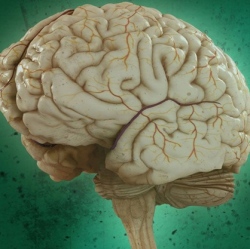
The first brain-to-brain telepathy-like communication between two participants via the Internet has been performed by University of Washington researchers. The experiment used a question-and-answer game. The goal is for the “inquirer” to determine which object the “respondent” is looking at from a list of possible objects.
The inquirer sends a question (e.g., “Does it fly?) to the respondent, who answers “yes” or “no” by mentally focusing on one of two flashing LED lights attached to the monitor. The respondent is wearing an electroencephalography (EEG) helmet.
By focusing on the “yes” light, the EEG device generates send a signal to the inquirer via the Internet to activate a magnetic coil positioned behind the inquirer’s head, which stimulates the visual cortex and causes the inquirer to see a flash of light (known as a “phosphene”). A “no” signal works the same way, but is not strong enough to activate the coil.
The experiment, detailed today in an open access paper in PLoS ONE, is the first to show that two brains can be directly linked to allow one person to guess what’s on another person’s mind. It is “the most complex brain-to-brain experiment, I think, that’s been done to date in humans,” said lead author Andrea Stocco, an assistant professor of psychology and researcher at UW’s Institute for Learning & Brain Sciences.
The experiment was carried out in dark rooms in two UW labs located almost a mile apart and involved five pairs of participants, who played 20 rounds of the question-and-answer game. Each game had eight objects and three questions. The sessions were a random mixture of 10 real games and 10 control games that were structured the same way.*
Participants were able to guess the correct object in 72 percent of the real games, compared with just 18 percent of the control rounds. Incorrect guesses in the real games could be caused by several factors, the most likely being uncertainty about whether a phosphene had appeared.
The study builds on the UW team’s initial experiment in 2013, which was the first to demonstrate a direct brain-to-brain connection between humans. Other scientists have connected the brains of rats and monkeys, and transmitted brain signals from a human to a rat, using electrodes inserted into animals’ brains. In the 2013 experiment, the UW team used noninvasive technology to send a person’s brain signals over the Internet to control the hand motions of another person.
The experiment evolved out of research by co-author Rajesh Rao, a UW professor of computer science and engineering, on brain-computer interfaces that enable people to activate devices with their minds. In 2011, Rao began collaborating with Stocco and Prat to determine how to link two human brains together.
In 2014, the researchers received a $1 million grant from the W.M. Keck Foundation that allowed them to broaden their experiments to decode more complex interactions and brain processes. They are now exploring the possibility of “brain tutoring,” transferring signals directly from healthy brains to ones that are developmentally impaired or impacted by external factors such as a stroke or accident, or simply to transfer knowledge from teacher to pupil.
The team is also working on transmitting brain states, for example, sending signals from an alert person to a sleepy one, or from a focused student to one who has attention deficit hyperactivity disorder, or ADHD.
